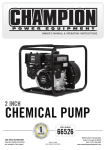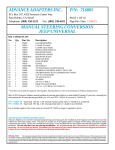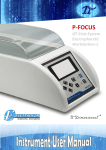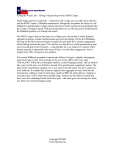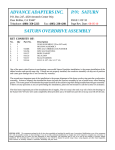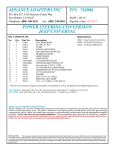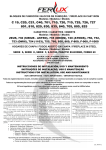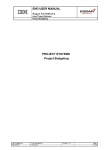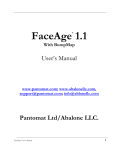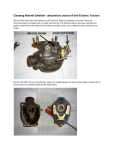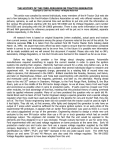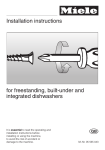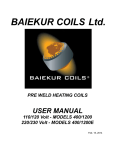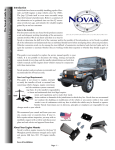Download Carter WO 101 Carter WO – 101
Transcript
Carter WO 101 [ Home ] [ Up ] [ Carter WO 101 ] [ Parts Kits ] [ Tools ] [ Disassembly ] [ Cleaning and Inspection ] [ Reassembly Throttle Body ] [ Reassembly Main Body ] [ Reassembly Main Body to Throttle Body ] [ Reassembly Bowl Cover ] [ Reassembly Air Horn ] [ Installiation and things to watch for ] [ Carter Bulletin ] Carter WO – 101 The Carter WO comes in two models, 596S on CJ2As before SN212110 and 636SA.on later CJ2As and all CJ3As. There are some differences but there are insignificant to this article. This carburetor is very simple as far as carburetors go. There are only five circuits. However, as with all carburetors, it is a precision device and needs to be handled as such. To allow for an easier understanding of the carburetor as a whole, This article will discuss the circuits individually. The five circuits are: float circuit, low-speed circuit, and high-speed circuit, accelerator pump circuit and finally the choke circuit. To enhance our understanding of carburetor operation, we must understand that the fuel in the fuel-bowl is at atmospheric pressure. This pressure is about 14.7 pounds per square inch absolute (PSIA). The engine and venturi of the carburetor creates a low pressure. The atmospheric pressure actually pushes the fuel up passageways into the throat of the carburetor where it is mixes with air to create a combustible mixture. The proportions of this mixture are critical and the carburetor’s job is to keep them optimum. To achieve these optimum proportions the orifices or jets in the carburetor are calibrated by the factory. The orifices must be kept at their designed size for the carburetor to perform its function optimally. Float Circuit: The float circuit controls the fuel level in the carburetor bowl. If the level is too high excessive fuel will be provided and the mixture will be too rich. Conversely, too low of a level will cause the mixture to be too lean. Both of these will lead to poor performance and can be taken to the extreme. An extremely high fuel level can cause raw fuel to spill into the venturi at idle causing flooding. An extremely low fuel level will result in the negative pressure at the end of the nozzle being insufficient to pull enough fuel from the bowl to allow the engine to do anything but Idle. end of the nozzle being insufficient to pull enough fuel from the bowl to allow the engine to do anything but Idle. Fuel enters the fuel bowl through a valve called a needle and seat. The needle is pressed against the seat by the float to shut off fuel. When the fuel level drops to a level where the needle moves away from the seat, fuel enters the bowl until the needle moves to the seat, thus shutting off fuel. The needle assembly is a three-piece device consisting of a pin, spring and needle. The float actually presses the pin and the spring dampens the bumps found when driving off-road. Fuel pressure plays an important part in the fuel level also. Too much pressure will cause a high fuel level and too little pressure will provide too low of a fuel level. A low fuel pressure could also be insufficient to provide the fuel required by the engine. Stalling could occur. The size of the orifice in the needle and seat assembly also effects the fuel level. Too large of an orifice will act like too much pressure and too small of an orifice will act like too little pressure. This is covered in detail here. Low-Speed Circuit: The low speed circuit is sometimes called the idle circuit. This circuit provides fuel to the engine from idle until the high-speed circuit kicks in at about 20 mph. The low speed circuit actually supplies some fuel during the operation of the high-speed circuit. The significance of this is very small after the high-speed circuit begins to operate. Intake manifold vacuum causes fuel from the fuel bowl to flow through the idle well jet and up the low-speed tube. Air enters through a throttle-plate bypass port and mixes with the fuel creating a fuel-rich air-fuel mixture. This mixture flows through an orifice known as the economizer. It continues past the air bleed and down to the idle port and idle adjustment needle opening. The idle-mixture adjustment screw provides the adjustment necessary at idle. The idle port is a slot that is partially covered by the throttle plate. Air from the top of this slot mixes with the air- The idle port is a slot that is partially covered by the throttle plate. Air from the top of this slot mixes with the airfuel mixture and finally achieves the correct proportions for combustion. As the throttle plate is opened, more of the slot is exposed. This allows more of the fuel-rich mixture to flow into the engine and the increased air, allowed by the open throttle-plate, leans the mixture to the correct proportion. This increase continues until the high-speed circuit can take over. Actually, the idle circuit continues to provide a small amount of fuel through the operation of the carburetor. High-Speed Circuit: The high-speed circuit begins to operate at about 20 mph. At this point, the velocity of air passing through the venturi of the carburetor reduces the pressure at the main nozzle and fuel begins to flow through the metering rod orifice. It continues past the metering rod and out the main nozzle where it mixes with the air flowing through the venturi. The correct amount of fuel required by the amount of air flowing through the throat is controlled by the taper of the metering rod. The metering rod is inside the metering rod orifice and tapered so as the throttle is opened wider more fuel passes through. At wide-open throttle (WOT) only the small tip of the metering rod is inside the metering rod orifice. Accelerator Pump Circuit: The accelerator pump circuit performs two functions. These include additional fuel during starting and additional fuel when accelerating quickly. During the engine starting operation, the intake vacuum is quite low. Therefore, neither the low-speed nor the highspeed circuits can supply an air-fuel mixture. When depressed, before starting the engine, the accelerator pump supplies a small amount of fuel to the intake manifold where the vapors are pulled into the cylinders during the cranking operation. This, along with the choke circuit (described later), assists in engine starting. When the throttle is opened the high-speed circuit reaction time doesn’t react as quickly as required. The accelerator pump provides increased fuel to the throat of the carburetor during these critical times. Operation of the accelerator pump is a simple pump circuit consisting of a spring-return cylinder, two check valves, a discharge nozzle and spring to prolong the flow. When the throttle is opened the cylinder rod is forced down forcing fuel in-between the check valves. The intake check valve closes and the exhaust check valve opens allowing fuel to flow up to the discharge nozzle in the carburetor throat. When the throttle is opened more quickly than the circuit can discharge fuel, the spring acts to prolong the fuel flow. This precisely what the high-speed circuit requires due to it’s relative slow reaction time. When the throttle begins to close the cylinder reverses it’s movement, closing the exhaust check valve and opening the intake check valve. Fuel then flows from the bottom of the bowl through a filter screen to recharge cylinder for the next operation. Choke Circuit: The choke circuit is used in starting and warming up a cold engine by providing a fuel rich mixture to the engine. The components of the choke circuit include, the choke plate mounted on a shaft and a lever at one end. A spring The components of the choke circuit include, the choke plate mounted on a shaft and a lever at one end. A spring attached to the lever is actuated by the choke linkage controlled by the choke cable attached to the knob in the driver’s compartment. A connector link is attached to the choke linkage and throttle linkage. During starting, the engine needs a fuel-rich mixture. When the choke is closed, all vacuum produced by the engine is trapped in the carburetor throat. This enables both the low-speed and high-speed circuits to provide fuel, thus inrichening the mixture. The connector link between the choke linkage and the throttle link opens the throttle slightly to enhance the vacuum above the throttle plate. Upon starting, the cold engine continues to require a fuel-rich mixture. The choke continues to enhance the vacuum in the carburetor throat where by a fuel-rich mixture continues. A bypass on the choke plate to restricts the vacuum that can be applied. continue back to top back to Rebuilding a Carter WO Visitors since February 2, 2004 Copyright Richard N. Meagley Sr. Last revised: May 25, 2007. Carter WO Rebuild [ Home ] [ Up ] [ No Spark? ] [ 24 Volt from 12 Volt conversion system. ] [ D25 Cross Shaft Removal ] [ DANA 25 - Grenaded ] [ Dana 41-2 Axle Replacement ] [ Carter WO Rebuild ] [ OneWireAlternator ] [ Broken Exhaust Manifold Stud Repair ] [ ShackleReversal - Main ] [ Valve Keeper Installiation Tool ] Carter WO Rebuild This will follow the rebuild of a Carter model WO as found on Willys L134 engines. This carb is from a 1953 CJ3A, but any Carter WO is similar enough that this information should be useful. All pictures on this page are links to a larger version. Just click on the photo to view and use your browser's back button to return Carter W-O 101 (a primer on how it works) In the beginning The parts kit Tools The disassembly The cleaning The inspection The reassembly Throttle body Main Body Main Body to Throttle Body Bowl Cover Air Horn Installation and things to watch for What to watch out for Needle and seat Tips and tricks. Carter Bulletin with repair pages In the beginning: I purchased the vehicle in good running condition and a rebuild wasn't absolutely necessary. However, I wanted to write a web page on the subject and thought rebuilding it would be a good idea. Below are some pictures before the rebuild. These were documentation photos for reference (incase I forgot where something went) Click on pictures for a larger version. Front view - Carter fuel filter attached. Rear, Carter filter is really a seperation bowl attached. Carb installed on engine continue back to top back to projects Visitors since January 26, 2004 Copyright Richard N. Meagley Sr. Last revised: May 25, 2007. seperation bowl Engine side - Linkage Parts Kits [ Home ] [ Up ] [ Carter WO 101 ] [ Parts Kits ] [ Tools ] [ Disassembly ] [ Cleaning and Inspection ] [ Reassembly Throttle Body ] [ Reassembly Main Body ] [ Reassembly Main Body to Throttle Body ] [ Reassembly Bowl Cover ] [ Reassembly Air Horn ] [ Installiation and things to watch for ] [ Carter Bulletin ] Parts kits: I purchased two rebuild kits. I have previously used the kits from The Carburetor Shop and have been very happy with them. However this time I also purchased a kit from Krage Motor Sports. Both kits were supplied without instructions or a metering rod gauge. If you have a Factory Service Manual the instructions are quite good. However without the metering rod setting gauge the metering rod can't be set properly and this is a major problem The kit from The Carburetor Shop is made in the U.S.A. and of excellent quality and would do for most rebuilds I have done. One item that would be nice to include is the base gasket with diffuser. The kit from Krage Motor Sports is an Omix Ada and probably made off shore. However it is considerably more complete. If you are going to "bring one back from the dead" or need to install bushings for the throttle or choke this kit has the throttle and choke plate screws. One obvious omission from this kit is the Idle Mixture adjustment screw. This screw sometimes gets damaged by a mechanic over-tightening it. Click on pictures for a larger version. The Carburetor Shop Rebuild Kit continue back to top Visitors since January 26, 2004 Krage Motor Sports Master Rebuild kit Tools [ Home ] [ Up ] [ Carter WO 101 ] [ Parts Kits ] [ Tools ] [ Disassembly ] [ Cleaning and Inspection ] [ Reassembly Throttle Body ] [ Reassembly Main Body ] [ Reassembly Main Body to Throttle Body ] [ Reassembly Bowl Cover ] [ Reassembly Air Horn ] [ Installiation and things to watch for ] [ Carter Bulletin ] Tools: You will need tools to rebuild the Carter WO carburetor. There is only one "special tool" required. The rest are either common tools or easily made from common tools. There is one item that is highly recommended that is a Factory Service Manual. These are available, as a reprint, for your vehicle from the various Willys sources. The float setting gauge can be anything 3/8" (0.375"). I used a 3/8" lathe tool bit, but a non worn down 3/8" drill shank works well also. The special straight shank screw drivers can be made from a regular screw driver by grinding off the wedge. Be careful fit the screw driver to the inside diameter of the screw threads with a little clearance but not so much as to allow the flat to not drive both sides of the jet or screw. The one special tool required is a metering rod gauge. This is available from The Carburetor Shop or can be made from the sketch I have provided. Accuracy is very important when this is made. Carter probably manufactured this within +/- 0,001". A skilled machinist should be able to make this from the sketch provided. Click on pictures for a larger version. Full assortment of tools used continue back to top Visitors since January 26, 2004 Copyright Richard N. Meagley Sr. Last revised: May 25, 2007. Left to right. 2 screw holding screwdrivers; Drawing of home made metering rod regular screw driver; 2 straight shank screw seting tool drivers; 2 small wire brushes Disassembly [ Home ] [ Up ] [ Carter WO 101 ] [ Parts Kits ] [ Tools ] [ Disassembly ] [ Cleaning and Inspection ] [ Reassembly Throttle Body ] [ Reassembly Main Body ] [ Reassembly Main Body to Throttle Body ] [ Reassembly Bowl Cover ] [ Reassembly Air Horn ] [ Installiation and things to watch for ] [ Carter Bulletin ] Disassembly: Remove the carb from the engine, and determine what pieces are included in the rebuild kit you will use. I used the Carburetor Shop kit. This kit includes the accelerator pump check valves, idle jet, metering jet and the accelerator pump plunger / return spring. It also includes all the gaskets and seals needed. Next assemble the tools you will need to do the job. I have some screw drivers that I have ground to just slip into the holes where the juts are located. In addition to the tools shown below, I use a "number drill set" to check orifice sizes. These drill ONLY are used for checking hole size and never drilling holes. I disassembled the entire carb. This ISN'T necessary. All the jets can be cleaned and checked for size without removal. I would suggest only removing what you will replace unless there is a specific reason for removal. In as much as there were no instructions in the rebuild kits, I referred to my Factory Service Manual (FSM) for disassembly. I start from the top (air horn) and work my way down to the base (throttle body). Being very careful to place all parts in an organizes manner. Even though this is a single venturi (one barrel), there are a lot of small parts. Click on pictures for a larger version. Here are the tools I used. A This spring actually opens good set of screw drivers is the choke plate. required. This shows how the choke During disassembly note spring is installed. how things were assembled. During disassembly, look for problems like this gasket that probably was leaking. Good gasket - deformed gasket This is the idle jet, it is fed from the bottom of the bowl This is the accelerator pump discharge nozzle Main jet and backup screw. Notice copper gasket around main jet. continue Parts asociated with Air Horn Inside the fuel feed port is the end of the "seat" portion of needle & seat Fuel flows up the idle tube. These are the accelerator pump check valves Parts associated with main body. Parts associates with the throttle body. Cleaning and Inspection [ Home ] [ Up ] [ Carter WO 101 ] [ Parts Kits ] [ Tools ] [ Disassembly ] [ Cleaning and Inspection ] [ Reassembly Throttle Body ] [ Reassembly Main Body ] [ Reassembly Main Body to Throttle Body ] [ Reassembly Bowl Cover ] [ Reassembly Air Horn ] [ Installiation and things to watch for ] [ Carter Bulletin ] Cleaning: After disassembling the carb, I wire brush each part to remove any loose debris, organize all parts. Then place the parts in the basket and dip in carb cleaner. I got my carb cleaner from NAPA it was about $15. Normally 20 min to 30 minutes is all that is required to dissolve the crud. As directed on the can rinse the part off with water. I then blow the part dry with compressed air. When the parts are dry, I use wire brushes to dislodge any buildup that remains and it's back to the dip tank for a final cleaning. Remember this is a carburetor and cleanliness is a must! Click on pictures for a larger version. Carb Cleaner. Comes with dip basket. Here the parts after cleraning. These are idle air bleeds. I am not sure of their size but I blow out with compressed air and insert a drill to assure they are clear. Air Horn and associated parts Throttle Body and associated parts Main body and associated parts back to top Inspection: Visually inspect all parts for wear, debris and breakage. Throttle shaft and choke shaft will probably have 'some' shaft play in them. The proper thing would be to remove the throttle and/or choke plate(s) and have 'some' shaft play in them. The proper thing would be to remove the throttle and/or choke plate(s) and have bushings installed. For most of us this is out of our league and replacement of the carburetor is the best option. Unless the shaft play is obviously excessive or you have the ability to install bushings yourself, I wouldn't consider fixing the shaft play. If shaft play is required to be fixed then I suggest calling The Carburetor Shop for an estimate on repair. I use a number drill set to check for clean jets. These drills have never seen a drill chuck as I use the shank size to check the orifice, The FSM defines the orifice sizes. I use compressed air and the shank end of the drill. Blow air through and slide the drill through. Always start with a drill 1 or 2 sizes smaller and work your way up to be sure you don't damage the orifice. NEVER FORCE the drill shank through the orifice. If a drill a couple sizes smaller won't slide through or air won't go through, it's back to the solvent tank for a while. If you some how break a drill off in a jet, replace the jet! Once all parts are clean and ready for reinstallation, then and ONLY then start reassembly. continue back to top Visitors since January 26, 2004 Copyright Richard N. Meagley Sr. Last revised: May 25, 2007. Reassembly Throttle Body [ Home ] [ Up ] [ Carter WO 101 ] [ Parts Kits ] [ Tools ] [ Disassembly ] [ Cleaning and Inspection ] [ Reassembly Throttle Body ] [ Reassembly Main Body ] [ Reassembly Main Body to Throttle Body ] [ Reassembly Bowl Cover ] [ Reassembly Air Horn ] [ Installiation and things to watch for ] [ Carter Bulletin ] Reassembly: Throttle Body Now the parts are all clean, you know what new parts you are going to be used, and everything is organized for assembly. What, the previous sentence is not true? STOP!! Do what is required to make that sentence true. OK. Now you are ready for assembly. In as much as I started disassembly with the air horn and finished with the throttle body, Let's start assembly with the throttle body, proceed to the main body, then the bowl cover and finish with the air horn. Click on pictures for a larger version. This is the trottle body and the associated parts. If you have The parts are assembled as shown. Turn the idle mixture a vacuum adviance distributor, the 1/8" pipe plug will be a adjustmet screw in all the way and back it out 1 1/2 turns. vacuum fitting. That's a good starting place. Set the throttle body aside and on to the main body. continue back to top Visitors since January 26, 2004 Copyright Richard N. Meagley Sr. Last revised: May 25, 2007 Reassembly Main Body [ Home ] [ Up ] [ Carter WO 101 ] [ Parts Kits ] [ Tools ] [ Disassembly ] [ Cleaning and Inspection ] [ Reassembly Throttle Body ] [ Reassembly Main Body ] [ Reassembly Main Body to Throttle Body ] [ Reassembly Bowl Cover ] [ Reassembly Air Horn ] [ Installiation and things to watch for ] [ Carter Bulletin ] Main Body The main body is where most of the action is. Click on pictures for a larger version. The large hole is the main Main jet. Notice angle cut Notice the angle cut on the jet passageway. (viewed on end, flats and washer. end of the main jet is flush from bottom of main body) The flats align with mating with the venturi. flats in the passageway. Gasket seals inside. Accelerator pump jet and installiation location. Here the accelerator pump is installed. (Viewed from the bottom) This is the accelerator Accelerator pump screen pump screen on a 'J' drill to installed in cover screw assure a round screen priot to installiation. Idle jet and passageway. This feeds from the lower portion of the fuel bowl. Main Jet backup screw. This holds the main jet in place and causes the seal to seal. Tighten securely but don't damage drive slots. After installing Main jet and backup screw, install the backup screw and new gasket. Notice this cover screw has Accelerator pump jet cover Accelerator pump check a tapered seal and doesn't screw installed. valves, screen and cover require a gasket. This carb plug ready for installation. had two of this style cover screw. This is the way the screen will be once installed. Here is the two accelerator Accelerator pump cover check valves and screen as screw installed they will function in the carb. Here is the idle jet installed This long skinny tube is the This shows the idle tube before the Idle tube is idle tube. It is pointing to installed and the cover installed. it's passageway. screw is laying on the bench. After the idle tube is installed, you can see both the idle jet and the end of the idle tube in the idle jet passageway. Idle jet cover installed. Idle tube cover installed Congratulations You have finished the main body. continue back to top Visitors since January 26, 2004 Copyright Richard N. Meagley Sr. Last revised: May 25, 2007 Metering orifice and passageway inside fuel bowl. Here the metering orifice is installed in the fuel bowl. Reassembly Main Body to Throttle Body [ Home ] [ Up ] [ Carter WO 101 ] [ Parts Kits ] [ Tools ] [ Disassembly ] [ Cleaning and Inspection ] [ Reassembly Throttle Body ] [ Reassembly Main Body ] [ Reassembly Main Body to Throttle Body ] [ Reassembly Bowl Cover ] [ Reassembly Air Horn ] [ Installiation and things to watch for ] [ Carter Bulletin ] Assemble the Main body to the Throttle body We are now ready to assemble the Main Body to the Throttle Body. There are two gaskets a spacer and 2 screws. Actually quite simple. Click on pictures for a larger version. Body with 2 gaskets and spacer One gasket installed Spacer installed Set this sub assembly aside and we will start on the bowl cover. continue back to top Visitors since January 26, 2004 Copyright Richard N. Meagley Sr. Last revised: May 25, 2007 Second Gasket installed 2 screws and the assembly is complete Reassembly Bowl Cover [ Home ] [ Up ] [ Carter WO 101 ] [ Parts Kits ] [ Tools ] [ Disassembly ] [ Cleaning and Inspection ] [ Reassembly Throttle Body ] [ Reassembly Main Body ] [ Reassembly Main Body to Throttle Body ] [ Reassembly Bowl Cover ] [ Reassembly Air Horn ] [ Installiation and things to watch for ] [ Carter Bulletin ] Bowl Cover This contain all, except for the idle mixture screw, the adjustments necessary on this carburetor. They are the float, and metering rod position. Click on pictures for a larger version. This is the accelerator pump parts and metering rod The spring holds the metering rod down against the pin and allows the metering rod to float up when it contacts the metering jet. Accelerator pump plunger Link is held on with this installed with link, showing clip the pump drive spring. Before setting metering rod, back out the throttle stop screw to allow the throttle plate to seat in the closed position. This is the pin resting on This is the accelerator the metering rod setup pump linkage. It also gauge. Assemble the bowl moves the metering rod. cover and gasket to the bowl and tighten securely. (ignore wrench for now) Accelerator pump is now installed onto bowl cover. This is the metering rod spring. Notice the spring goes through the hole in the metering rod. Clip holds the metering rod on the pin. This is the special tool Here is the accelerator resting in the metering pump spring. orifice. It will be used to set the position of the metering rod pin. Here the accelerator pump spring is installed. Install the linkage as shown Install the accelerator pump and attach with a hair pin linkage on the throttle clip. linkage and hold in place with the spring clip, Ok, here goes! While holding the throttle closed and the pin against the metering rod gauge tighten the nut on the pin. Remove bowl cover, put The seat is now installed. gauge in safe place and get The 3 piece needle is ready to install and set the shown in assembly opder float. Assemble the needle and install in the seat. Here are the float parts. This tang is bent slightly to Once the float is set install position the float at the gasket. precisely 3/8" from bowl cover (without gasket) continue back to top Visitors since January 26, 2004 Copyright Richard N. Meagley Sr. Last revised: May 25, 2007 Install metering rod as previously shown reinstall bowl cover. Here is the float resting on he springloaded needle. A 3/8" spacer is used for a gauge. A dowel pin or drill shank works well also. Note - Gasket NOT installed Reassembly Air Horn [ Home ] [ Up ] [ Carter WO 101 ] [ Parts Kits ] [ Tools ] [ Disassembly ] [ Cleaning and Inspection ] [ Reassembly Throttle Body ] [ Reassembly Main Body ] [ Reassembly Main Body to Throttle Body ] [ Reassembly Bowl Cover ] [ Reassembly Air Horn ] [ Installiation and things to watch for ] [ Carter Bulletin ] Air Horn All the hard work is done. Next we assemble the air horn. Click on pictures for a larger version. Here is the Air Horn ready for installiation. Install the choke & throttle cable support and install the choke opening spring. continue back to top Visitors since January 26, 2004 Copyright Richard N. Meagley Sr. Last revised: May 25, 2007 When the air horn is installed be careful of the accelerator pump and metering linkage. Slide the choke to throttle linkage onto the throttle first then onto the choke end. Here is the choke & throttle cable support. Install the spring inder the choke end and hold in place with a hair pin clip. Installiation and things to watch for [ Home ] [ Up ] [ Carter WO 101 ] [ Parts Kits ] [ Tools ] [ Disassembly ] [ Cleaning and Inspection ] [ Reassembly Throttle Body ] [ Reassembly Main Body ] [ Reassembly Main Body to Throttle Body ] [ Reassembly Bowl Cover ] [ Reassembly Air Horn ] [ Installiation and things to watch for ] [ Carter Bulletin ] Installing on the engine Before installing on the engine set the idle mixture screw at a setting that will allow the carburetor to function. This is 1 1/2 turns from fully seated. Turn in the idle mixture screw till it stops and then back out 1 1/2 turns. Also set the idle speed screw at a position the should allow the engine to idle. This is two (2) turns after the screw begins to open the throttle. When installing on the engine be sure to use new gasket(s), either the diffuser gasket or a thickness equivalent. This thickness is required to prevent the carb hold down studs from contacting the carb body and preventing a seal. back to top Things to watch-out for: Click on pictures for a larger version. back to top back to projects Visitors since January 26, 2004 Copyright Richard N. Meagley Sr. Last revised: May 25, 2007.




















